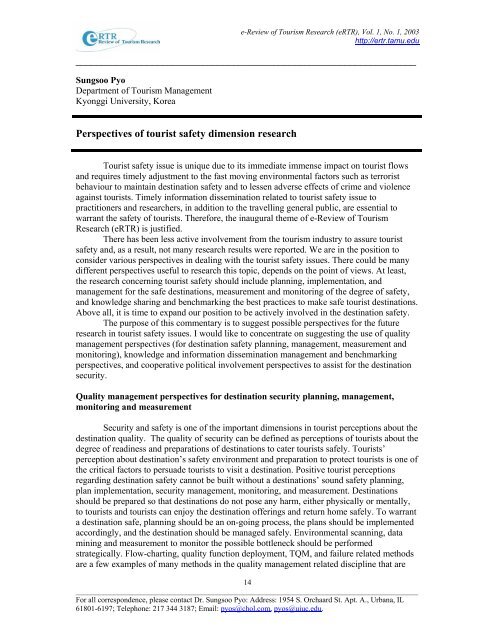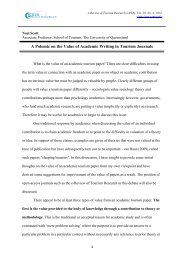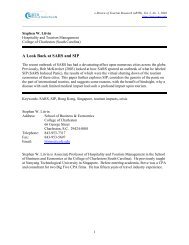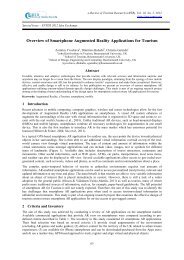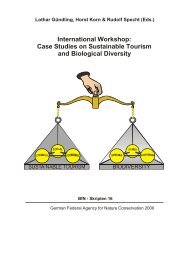Download PDF - e-Review of Tourism Research (eRTR)
Download PDF - e-Review of Tourism Research (eRTR)
Download PDF - e-Review of Tourism Research (eRTR)
You also want an ePaper? Increase the reach of your titles
YUMPU automatically turns print PDFs into web optimized ePapers that Google loves.
e-<strong>Review</strong> <strong>of</strong> <strong>Tourism</strong> <strong>Research</strong> (<strong>eRTR</strong>), Vol. 1, No. 1, 2003<br />
http://ertr.tamu.edu<br />
___________________________________________________________________<br />
Sungsoo Pyo<br />
Department <strong>of</strong> <strong>Tourism</strong> Management<br />
Kyonggi University, Korea<br />
Perspectives <strong>of</strong> tourist safety dimension research<br />
Tourist safety issue is unique due to its immediate immense impact on tourist flows<br />
and requires timely adjustment to the fast moving environmental factors such as terrorist<br />
behaviour to maintain destination safety and to lessen adverse effects <strong>of</strong> crime and violence<br />
against tourists. Timely information dissemination related to tourist safety issue to<br />
practitioners and researchers, in addition to the travelling general public, are essential to<br />
warrant the safety <strong>of</strong> tourists. Therefore, the inaugural theme <strong>of</strong> e-<strong>Review</strong> <strong>of</strong> <strong>Tourism</strong><br />
<strong>Research</strong> (<strong>eRTR</strong>) is justified.<br />
There has been less active involvement from the tourism industry to assure tourist<br />
safety and, as a result, not many research results were reported. We are in the position to<br />
consider various perspectives in dealing with the tourist safety issues. There could be many<br />
different perspectives useful to research this topic, depends on the point <strong>of</strong> views. At least,<br />
the research concerning tourist safety should include planning, implementation, and<br />
management for the safe destinations, measurement and monitoring <strong>of</strong> the degree <strong>of</strong> safety,<br />
and knowledge sharing and benchmarking the best practices to make safe tourist destinations.<br />
Above all, it is time to expand our position to be actively involved in the destination safety.<br />
The purpose <strong>of</strong> this commentary is to suggest possible perspectives for the future<br />
research in tourist safety issues. I would like to concentrate on suggesting the use <strong>of</strong> quality<br />
management perspectives (for destination safety planning, management, measurement and<br />
monitoring), knowledge and information dissemination management and benchmarking<br />
perspectives, and cooperative political involvement perspectives to assist for the destination<br />
security.<br />
Quality management perspectives for destination security planning, management,<br />
monitoring and measurement<br />
Security and safety is one <strong>of</strong> the important dimensions in tourist perceptions about the<br />
destination quality. The quality <strong>of</strong> security can be defined as perceptions <strong>of</strong> tourists about the<br />
degree <strong>of</strong> readiness and preparations <strong>of</strong> destinations to cater tourists safely. Tourists’<br />
perception about destination’s safety environment and preparation to protect tourists is one <strong>of</strong><br />
the critical factors to persuade tourists to visit a destination. Positive tourist perceptions<br />
regarding destination safety cannot be built without a destinations’ sound safety planning,<br />
plan implementation, security management, monitoring, and measurement. Destinations<br />
should be prepared so that destinations do not pose any harm, either physically or mentally,<br />
to tourists and tourists can enjoy the destination <strong>of</strong>ferings and return home safely. To warrant<br />
a destination safe, planning should be an on-going process, the plans should be implemented<br />
accordingly, and the destination should be managed safely. Environmental scanning, data<br />
mining and measurement to monitor the possible bottleneck should be performed<br />
strategically. Flow-charting, quality function deployment, TQM, and failure related methods<br />
are a few examples <strong>of</strong> many methods in the quality management related discipline that are<br />
14<br />
__________________________________________________________________________________________<br />
For all correspondence, please contact Dr. Sungsoo Pyo: Address: 1954 S. Orchaard St. Apt. A., Urbana, IL<br />
61801-6197; Telephone: 217 344 3187; Email: pyos@chol.com, pyos@uiuc.edu.
e-<strong>Review</strong> <strong>of</strong> <strong>Tourism</strong> <strong>Research</strong> (<strong>eRTR</strong>), Vol. 1, No. 1, 2003<br />
http://ertr.tamu.edu<br />
possibly useful not only to the researchers <strong>of</strong> the academic field but also to practitioners such<br />
as law enforcement agents.<br />
Knowledge management and benchmarking<br />
Dissemination and sharing <strong>of</strong> knowledge and information is critical to maintain safety<br />
in destinations (for the recent research and discussion regarding knowledge management in<br />
hospitality and tourism, see special issue in knowledge management, Vol. 3, No. 3/4, Journal<br />
<strong>of</strong> Quality Assurance in Hospitality and <strong>Tourism</strong>, forth-coming). It is especially true when the<br />
movement <strong>of</strong> people is global, and the frequency <strong>of</strong> travel and the speed <strong>of</strong> transportation are<br />
overwhelming. Information and knowledge related to destination safety can be stored and<br />
shared between those who should protect tourists (Pyo, Uysal, & Chang, 2002). Having<br />
readily accessible knowledge that indicates what destinations should do can be a great help to<br />
make destination safe. During the knowledge collection process, best practices in destination<br />
safety management can be found and the practices can be used for benchmarking (for the<br />
recent benchmarking studies, please see to Pyo (2001).<br />
Proactive involvement<br />
In general, law enforcement protecting tourists has limited access to persons from<br />
other organizations. Consequently, research on destination safety tend to be descriptive<br />
impact studies about the unfortunate accidents, crimes or violence after incidents. Serving in<br />
actual law enforcement scene may not be possible. However, proactive research and<br />
cooperation with law enforcement organizations could be achieved. Although, law<br />
enforcement agents are knowledgeable in destination safety issues, bringing in the research<br />
results <strong>of</strong> related industry’s pr<strong>of</strong>essionals should be useful. It is especially true when there is<br />
no tourism safety specialist in law enforcement organizations. <strong>Tourism</strong> researchers can<br />
provide knowledge about violence and crime patterns against tourists and new theoretical<br />
research results. Themes <strong>of</strong> proactive research may include destination safety planning,<br />
management, environmental scanning and data mining, contingency planning, new<br />
theoretical developments and findings, and best practices <strong>of</strong> other areas. Cooperative works<br />
between tourism academia and low enforcement practitioners must enhance the destinations<br />
safe.<br />
Implications<br />
Destination safety issues should be everybody’s concern including tourists, destination<br />
residents, business people, politicians, policy makers, and others, although the views about<br />
crime and violence impact may be different. One <strong>of</strong> the missions in the tourism academic<br />
field and industry should be contributing to ensure the safety <strong>of</strong> a tourist destination.<br />
Maintaining safe destinations is an important prerequisite to attract a sufficient number <strong>of</strong><br />
tourists and to make destination visit enjoyable. Classifying acts <strong>of</strong> crime and violence at<br />
tourism destinations (Pizam, 1999) and policy research on traveler safety and security (Smith,<br />
1999) are examples <strong>of</strong> proactive studies. Multidisciplinary approaches could be helpful to<br />
produce proactive researches. One <strong>of</strong> the disciplines can be quality management. Knowledge<br />
and information sharing activities should be efficiently operated so that best practices are<br />
shared and knowledge and information required for the destination security management are<br />
in hand.<br />
15<br />
__________________________________________________________________________________________<br />
For all correspondence, please contact Dr. Sungsoo Pyo: Address: 1954 S. Orchaard St. Apt. A., Urbana, IL<br />
61801-6197; Telephone: 217 344 3187; Email: pyos@chol.com, pyos@uiuc.edu.
e-<strong>Review</strong> <strong>of</strong> <strong>Tourism</strong> <strong>Research</strong> (<strong>eRTR</strong>), Vol. 1, No. 1, 2003<br />
http://ertr.tamu.edu<br />
References<br />
Pizam, A. (1999). A comprehensive approach to classifying acts <strong>of</strong> crime and violence<br />
at tourism destinations. Journal <strong>of</strong> Travel <strong>Research</strong>, 38(1), 5-12.<br />
Pyo, S. (ed.) (2001). Benchmarks in Hospitality and <strong>Tourism</strong>. New York: The Haworth<br />
Hospitality Press. (This volume is equivalent to Vol. 2, No. 1/2, Journal <strong>of</strong> Quality Assurance<br />
in Hospitality and <strong>Tourism</strong>).<br />
Pyo, S., Uysal, M., and Chang, H. (2002). Knowledge discovery in database for tourist<br />
destinations. Journal <strong>of</strong> Travel <strong>Research</strong>, 40(4), 396-403.<br />
Smith, G. (1999). Toward a United States policy on traveler safety and security.<br />
Journal <strong>of</strong> Travel <strong>Research</strong>, 38(1), 62-65.<br />
16<br />
__________________________________________________________________________________________<br />
For all correspondence, please contact Dr. Sungsoo Pyo: Address: 1954 S. Orchaard St. Apt. A., Urbana, IL<br />
61801-6197; Telephone: 217 344 3187; Email: pyos@chol.com, pyos@uiuc.edu.


